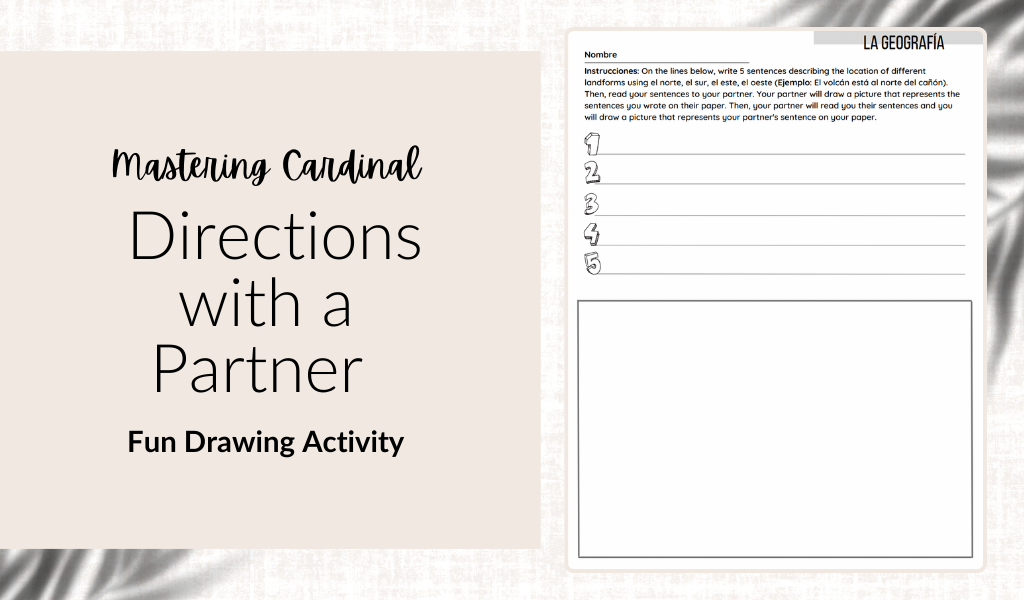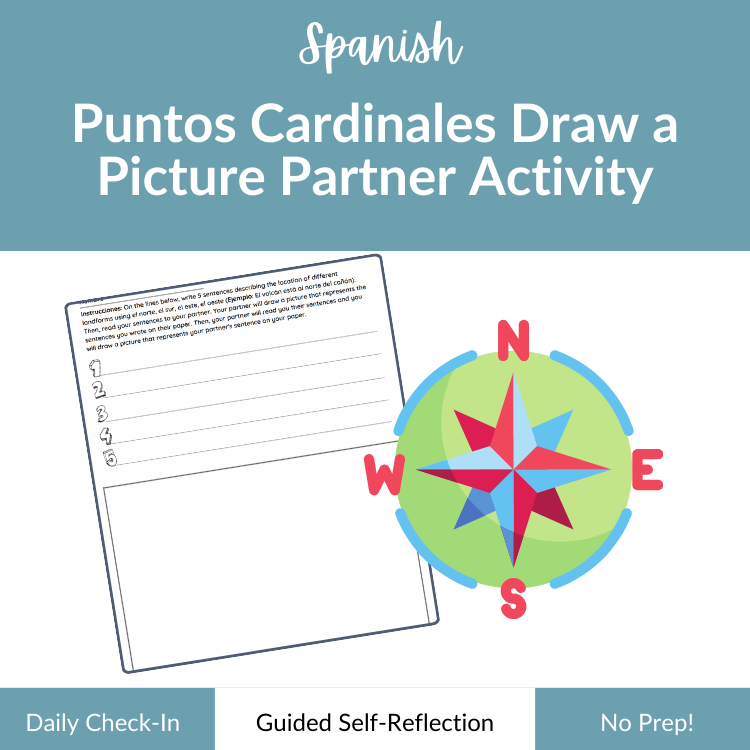Hey there, Joyful Journey Makers! 
The Science of Drawing & Language Learning
You might think of drawing as a simple, fun classroom activity (and yes, it is fun!), but it’s also so much more when it comes to learning. When students engage in drawing, they activate the brain’s visual-spatial and motor areas, which are crucial for memory retention and cognitive processing. Pairing drawing with speaking—like in the Puntos Cardinales Partner Activity—takes it to the next level by engaging multiple senses and cognitive functions simultaneously.
Here’s how drawing supports language learning:
Why Pair Drawing & Speaking?
When students use both drawing and speaking, they’re activating different parts of the brain. Visualizing vocabulary terms, such as “el norte” or “el volcán,” engages the brain’s occipital lobe, while speaking activates the frontal lobe (Pashler et al., 2008). This dual engagement leads to:
- Deeper understanding: Students create meaningful connections between words and images.
- Increased retention: Concepts are reinforced visually and verbally, improving long-term memory.
- Enhanced focus: Drawing helps keep students focused and engaged, creating a calm, centered classroom environment.
How to Make Drawing and Speaking Activities Successful
Ready to bring this activity into your classroom? Here are a few tips to ensure that it runs smoothly and maximizes student learning:
- Set Clear Expectations: Always start with clear instructions (this one’s non-negotiable!). Explain what students need to do—whether it’s writing sentences about landforms or speaking them aloud while their partner draws. Encourage students to focus on communicating meaning clearly rather than perfection. (Pro tip: Remind them that drawing volcanoes isn’t about being the next Picasso—it’s about having fun with the language.)
- Create a Calm Environment: Drawing is naturally calming, but it can get chaotic if students lose focus. Set a calm tone by playing soft music in the background or dimming the lights slightly to encourage concentration. This will create a quiet space for creativity and focus.
- Positive Reinforcement: Celebrate both the artistic efforts and the language practice! Whether students draw the best volcano or the simplest sketch, it’s about the process, not the product. Reinforce the importance of speaking the language while drawing.
- Pair Students Thoughtfully: Mix up the partners! Pair a novice with an expert to encourage learning through peer modeling. Or, if you’re working on building confidence, pair two novices together so they can grow without feeling intimidated. (Pro tip: Avoid always pairing high achievers together—sometimes a mixed-ability pairing leads to the best learning!)
Classroom Management: Pitfalls & Solutions
Of course, even the best-laid plans can run into a few bumps. Here are some common classroom management pitfalls when using drawing and speaking activities, along with quick fixes:
- Pitfall #1: Off-Task Conversations: Students can get carried away talking about anything but Spanish. (We’ve all been there.)
- Solution: Keep students on track by circulating the room and reminding them to use their Spanish vocabulary. Gentle reminders like, “What direction is that landform in?” will help keep them focused.
- Pitfall #2: Artistic Anxiety: Some students might hesitate, thinking they’re not good at drawing.
- Solution: Encourage a growth mindset by reminding students that it’s the language that counts—not their artistic skills. (Besides, have you ever seen a stick figure that wasn’t charming?) Celebrate effort over perfection.
- Pitfall #3: Lack of Engagement: Sometimes, students can get too quiet.
- Solution: Add an element of competition or fun. For example, see who can finish their drawing first while still accurately following the directions. (Winner gets to share their masterpiece with the class!)
Puntos Cardinales (Spanish Cardinal Directions): Draw a Picture Partner Activity
Introducing Puntos Cardinales: Draw a Picture Partner Activity
This activity is a perfect blend of creativity, partner work, and Spanish language practice. It’s designed to reinforce cardinal directions (el norte, el sur, el este, el oeste) while giving students a chance to practice writing, speaking, and drawing. Here’s how it works:
- Step 1: Students write 5 sentences about the location of different landforms using cardinal directions (e.g., “El volcán está al norte del cañón”).
- Step 2: Students take turns reading their sentences to their partner, who will then draw a picture that represents the sentences.
- Step 3: They switch roles and repeat the process.
5 Ways to Use Puntos Cardinales in Your Classroom:
- Early Finisher Activity: This is a great option for students who finish early and need a productive, quiet activity.
- Partner Work: Use this as a partner activity for mixed-ability pairs. Students can work together to reinforce cardinal directions and geographical vocabulary.
- Vocabulary Review: Add this activity to a vocabulary review session where students need to practice both writing and speaking in Spanish.
- Art Integration: Incorporate this activity into a cross-curricular lesson that blends art and geography.
- Classroom Display: Let students showcase their creative drawings on a “Geography Wall” in the classroom.
The Gist of it All
Drawing and speaking activities like Puntos Cardinales tap into students’ creativity while activating key areas of the brain for language learning. By pairing visual and verbal elements, students can boost their memory retention, increase focus, and feel confident about their Spanish skills. Plus, let’s be real—who doesn’t love a good drawing activity?
Ready to make Spanish learning fun and interactive? Give Puntos Cardinales a try and watch your students thrive!

Resources
Sousa, D. A. (2016). How the brain learns (5th ed.). Corwin Press.
Pashler, H., McDaniel, M., Rohrer, D., & Bjork, R. (2008). Learning styles: Concepts and evidence. Psychological Science in the Public Interest, 9(3), 105–119.
Gardner, H. (1983). Frames of Mind: The Theory of Multiple Intelligences. Basic Books.


